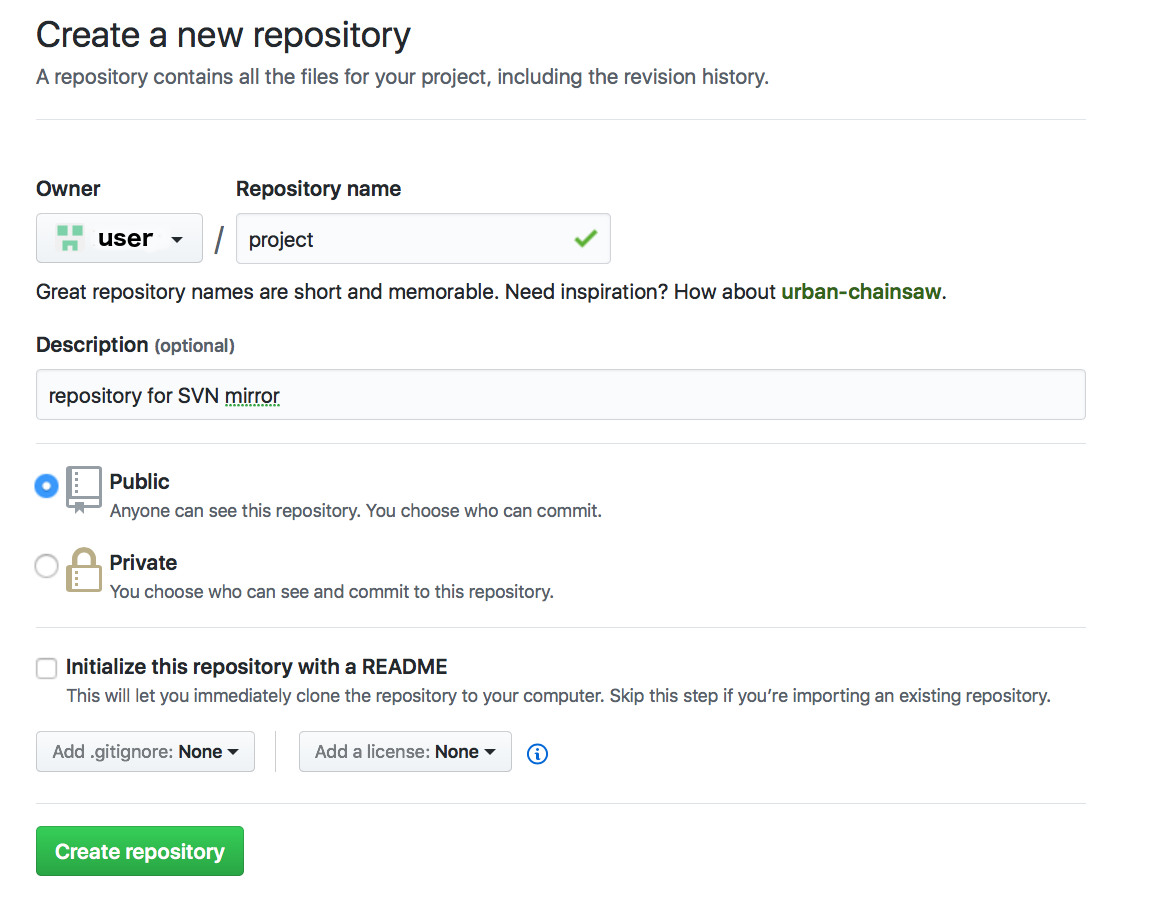- login to GitHub and create a new repository:

Run this command on behalf of the same user you use to serve Git repository:
$ subgit configure --layout auto --trunk trunk SVN_URL GIT_REPO |
where
SVN_URL– the URL to the SVN project.GIT_REPO– the path to the new Git repository where data from the SVN project will be imported to.TRUNK– the path, relative toSVN_URL, leading to the SVN directory that acts as the main line of development.
$ subgit configure --layout auto --trunk trunk http://svn.example.com/svn/repository/project ./project.git SubGit version 3.2.4 ('Bobique') build #3670 Configuring writable Git mirror of remote Subversion repository: Subversion repository URL : http://svn.example.com/svn/repository/project Git repository location : ./project.git Git repository is served by GitLab, hooks will be installed into 'custom_hooks' directory. Detecting peg location... Authentication realm: <http://svn.example.com/:80> Subversion Repository Username [git]: user Password for 'user': Peg location detected: r10248 project/trunk Fetching SVN history... Done. Growing trees... Done. Project origin detected: r1 project/trunk Building branches layouts... Done. Combing beards... Done. Generating SVN to Git mapping... Done. CONFIGURATION SUCCESSFUL To complete SubGit installation do the following: 1) Adjust Subversion to Git branches mapping if necessary: /var/opt/gitlab/git-data/repositories/user/project.git/subgit/config 2) Define at least one Subversion credentials in default SubGit passwd file at: /var/opt/gitlab/git-data/repositories/user/project.git/subgit/passwd OR configure SSH or SSL credentials in the [auth] section of: /var/opt/gitlab/git-data/repositories/user/project.git/subgit/config 3) Optionally, add custom authors mapping to the authors.txt file(s) at: /var/opt/gitlab/git-data/repositories/user/project.git/subgit/authors.txt 4) Run SubGit 'install' command: subgit install ./project.git
Specify authors mapping
Configure authors mapping in default authors mapping file:GIT_REPOS/subgit/authors.txt
Or change
core.authorsoption so that it points to the global authors mapping file.Find more details about authors mapping in the Authors mapping article.
Import data into local Git repository by the command:
$ subgit import GIT_REPO |
where
GIT_REPO – the path to the Git repository.
|
step into the newly created local Git repository
$ cd GIT_REPO
add a remote to the local Git repository:
$ git remote add github GITHUB_REPO
where
GITHUB_REPO– GitHub project URL.
push local repository content into GitHub repository:
$ git push github --all --follow-tags
When the command completed, the local repository is not needed anymore and can be removed:
$ rm -Rf GIT_REPO
All the files from SVN are now on GitHub, so you can clone your GitHub repository and start to work with it:
$ git clone GITHUB_REPO WORK_TREE |
where
WORK_TREE– the path to your working copy.GITHUB_REPO– GitHub project URL
|
If Git warns you that you are cloning an empty repository and you don't see your files in the working tree, most probably automatic branches and tags mapping didn't work correctly. In this case, mapping has to be set manually, see details on mapping in Branches and tags mapping. |
If you have encountered any problems, see the following guides for more details: